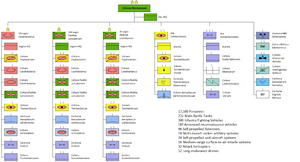Latin Army: Difference between revisions
Arthurista (talk | contribs) |
Arthurista (talk | contribs) |
||
| (19 intermediate revisions by 2 users not shown) | |||
| Line 1: | Line 1: | ||
{{ | {{in use}} | ||
{{Region_icon_Ajax}} | {{Region_icon_Ajax}} | ||
{{Infobox military unit | {{Infobox military unit | ||
| Line 70: | Line 70: | ||
===Higher Organisation=== | ===Higher Organisation=== | ||
[[File:Latin Division.png|thumb|right|300px|The organisation chart of the 3rd Mechanised Division, Latin Army, comprised of the VII Armoured Legion, VIII Mechanised Infantry Legion and IX Mechanised Infantry Legion and support elements.]] | |||
The main forces of the Imperial Army is organised as 21 Legiones of combat troops, supported by a number Alae which perform combat support functions. These forces are grouped into seven divisions. | The main forces of the Imperial Army is organised as 21 Legiones of combat troops, supported by a number Alae which perform combat support functions. These forces are grouped into seven divisions. | ||
| Line 76: | Line 76: | ||
The two Armoured Divisions (Divisio Cataphractarius) are the Imperial Army's heavy forces. They are optimised for a {{wp|conventional warfare}} scenario on the Belisarian continent in support of Latium's BC neighbours. The Armoured Divisions consist of two Armoured Legions (Legio Cataphractius), an Armoured Infantry Legion (Legio Pedites Loricatorum), an Artillery Ala (Alae Tormentorum), a Combat Sustainment Ala (Ala Sustentationem) and other supporting elements. | The two Armoured Divisions (Divisio Cataphractarius) are the Imperial Army's heavy forces. They are optimised for a {{wp|conventional warfare}} scenario on the Belisarian continent in support of Latium's BC neighbours. The Armoured Divisions consist of two Armoured Legions (Legio Cataphractius), an Armoured Infantry Legion (Legio Pedites Loricatorum), an Artillery Ala (Alae Tormentorum), a Combat Sustainment Ala (Ala Sustentationem) and other supporting elements. | ||
The four Mechanised Divisions are a more versatile force. They each contain one Armoured Legion and one Armoured Infantry Legion optimised for conventional warfare, as well as the other auxiliary units of an Armoured Division. However, in recent years, their second Armoured Infantry Legions | The four Mechanised Divisions are a more versatile force. They each contain one Armoured Legion and one Armoured Infantry Legion optimised for conventional warfare, as well as the other auxiliary units of an Armoured Division. Until 2010, Mechanised Divisions possessed a second Armoured Infantry Legion. However, in recent years, their second Armoured Infantry Legions have been replaced by a Motorised Legion (Legio Rapidus), equipped with 8-wheeled combat vehicles of a common family. | ||
The Rapid Intervention Division (Divisio Intreventus Rapidus) is intended as a strategically mobile rapid reaction force for peacekeeping and other operations beyond Belisaria. It consists of three elite units, the Airborne Legion (Legio Pedite Aerium), the Mountain Infantry Legion (Legio Pedite Montem) and the Marine Infantry Legion (Legio Pedite Marinus). The latter is administratively part of the Imperial Navy, but grouped under the RID for operational purposes. | The Rapid Intervention Division (Divisio Intreventus Rapidus) is intended as a strategically mobile rapid reaction force for peacekeeping and other operations beyond Belisaria. It consists of three elite units, the Airborne Legion (Legio Pedite Aerium), the Mountain Infantry Legion (Legio Pedite Montem) and the Marine Infantry Legion (Legio Pedite Marinus). The latter is administratively part of the Imperial Navy, but grouped under the RID for operational purposes. | ||
The six heavy divisions are grouped into two army corps, the I and II Corps. The Rapid Reaction Division is not subordinated to a Corps HQ and functions as a general staff reserve. | |||
===Legiones and Alae=== | ===Legiones and Alae=== | ||
| Line 88: | Line 88: | ||
An Armoured or Armoured Infantry Legion possesses a balanced mix of main battle tanks, infantry fighting vehicles, self-propelled howitzers and other assets. They are heavy combat units intended for {{Wp|conventional warfare}}. The former is suitable for open terrain. The latter, which contains a higher proportion of infantry, is more optimised for mixed terrain in which force versatility is important. | An Armoured or Armoured Infantry Legion possesses a balanced mix of main battle tanks, infantry fighting vehicles, self-propelled howitzers and other assets. They are heavy combat units intended for {{Wp|conventional warfare}}. The former is suitable for open terrain. The latter, which contains a higher proportion of infantry, is more optimised for mixed terrain in which force versatility is important. | ||
A Motorised Legion (Legio Rapidus) consists of infantry cohorts mounted in eight-wheeled {{wp|Freccia IFV|VCC-3 Sagita}} vehicles and its variants. Compared to conventional mechanised forces, these are designed for rapid movement along motorways in regions with well-developed infrastructure and is capable of carrying out a wide-variety of military operations of different intensities, from assistance to civil power to combat against sophisticated opposition | A Motorised Legion (Legio Rapidus) consists of infantry cohorts mounted in eight-wheeled {{wp|Freccia IFV|VCC-3 Sagita}} vehicles and its variants. Compared to conventional mechanised forces, these are designed for rapid movement along motorways in regions with well-developed infrastructure and is capable of carrying out a wide-variety of military operations of different intensities, from assistance to civil power to combat against sophisticated opposition. | ||
The Airborne Legion (Legio X Pedite Aerium) is an elite light infantry formation which can deploy by {{wp|Airborne forces|parachute}} or {{wp|Air assault}} helicopter. Most of the Imperial Army's special forces personnel originate from this unit. The Mountain Infantry Legion (Legio XI Pedite Montem) receives training in high altitude and cold weather operations | The Marine Infantry Legion (Legio XII Pedite Marinus) is trained in {{Wp|Amphibious warfare}}, although on land they operate as mechanised infantry, transported in the amphibious {{wp|Iveco SuperAV|VCC-4 Neptunus}} wheeled APC, which replaced the tracked {{wp|Assault Amphibious Vehicle|AAV}} in around 2012. | ||
The Airborne Legion (Legio X Pedite Aerium) is an elite light infantry formation which can deploy by {{wp|Airborne forces|parachute}} or {{wp|Air assault}} helicopter. Most of the Imperial Army's special forces personnel originate from this unit. | |||
The Mountain Infantry Legion (Legio XI Pedite Montem) receives training in high altitude and cold weather operations. | |||
Aside from Legions, the Imperial Army also possesses a large number of Alae, some of which come under the command of one of the four divisions, others are independent. They are legion-sized groupings of forces not intended to enter direct combat, such as artillery, engineers, signal troops, helicopters, logistical support and so forth. The Alae have been described as the direct descendant of historical Auxilia regiments. | Aside from Legions, the Imperial Army also possesses a large number of Alae, some of which come under the command of one of the four divisions, others are independent. They are legion-sized groupings of forces not intended to enter direct combat, such as artillery, engineers, signal troops, helicopters, logistical support and so forth. The Alae have been described as the direct descendant of historical Auxilia regiments. | ||
| Line 129: | Line 133: | ||
|----- | |----- | ||
|- style="background:#efefef; color:black" | |- style="background:#efefef; color:black" | ||
| {{wp|Beretta | | {{wp|Beretta APX|APX}} | ||
| [[File: | | [[File:Beretta-APX-9mm.jpg|125px]] | ||
| {{flag|Latium}} | | {{flag|Latium}} | ||
| Pistol | | Pistol | ||
| 9×19mm | | 9×19mm | ||
| | | Replaced the {{wp|Beretta 92|P76}} in 2016 | ||
|----- | |----- | ||
|- style="background:#efefef; color:black" | |- style="background:#efefef; color:black" | ||
| {{wp| | | {{wp|Beretta M12|M12}} | ||
| [[File: | | [[File:M12S Beretta.jpg|125px]] | ||
| {{flag|Latium}} | | {{flag|Latium}} | ||
| Sub-machinegun | | Sub-machinegun | ||
| Line 147: | Line 151: | ||
| {{wp|Beretta_Cx4_Storm#Mx4_Storm|MX4}} | | {{wp|Beretta_Cx4_Storm#Mx4_Storm|MX4}} | ||
| [[File:CX4 Sideview.png|125px]] | | [[File:CX4 Sideview.png|125px]] | ||
| {{flag|Latium}} | |||
| Sub-machinegun | |||
| 9×19mm | |||
| | |||
|----- | |||
|- style="background:#efefef; color:black" | |||
| {{wp|Beretta PMX|PMX}} | |||
| [[File:Pmx bdt zoom002-1-850x442.png|125px]] | |||
| {{flag|Latium}} | | {{flag|Latium}} | ||
| Sub-machinegun | | Sub-machinegun | ||
| Line 193: | Line 205: | ||
|----- | |----- | ||
|- style="background:#efefef; color:black" | |- style="background:#efefef; color:black" | ||
| {{wp| | | {{wp|Desert Tech HTI|HTI}} | ||
| [[File: | | [[File:HTI-Right-Profile.jpg|125px]] | ||
| {{flag|Latium}} | | {{flag|Latium}} | ||
| Anti-materiel rifle | | Anti-materiel rifle | ||
| Line 346: | Line 358: | ||
| {{flag|Latium}} | | {{flag|Latium}} | ||
| Main battle tank | | Main battle tank | ||
|900 | |900 - those in active service have largely been upgraded to the {{wp|Ariete#Ariete_AMV|AMV}} standard. | ||
|----- | |----- | ||
|{{Wp|OF-40|VC80}} | |{{Wp|OF-40|VC80}} | ||
| Line 372: | Line 384: | ||
|Equips the Imperial Marines. | |Equips the Imperial Marines. | ||
|----- | |----- | ||
| {{wp| | | {{wp|Variants_of_the_M113_armored_personnel_carrier#Italy|VCC-1 & VCC-2 Testudo}} | ||
| [[File:US_M113_in_Samarra_Iraq.jpg|125px]] | | [[File:US_M113_in_Samarra_Iraq.jpg|125px]] | ||
| {{flag|Latium}} | | {{flag|Latium}}/{{flag|Belfras}} | ||
| Armoured Personnel Carrier | | Armoured Personnel Carrier | ||
| 1,500+, mostly in storage and to be phased out | | Latium's indigenous adaptation of the Belfrasian {{wp|M113 armored personnel carrier|BMS Testudo}}. 1,500+ built, mostly in storage and to be phased out | ||
|----- | |----- | ||
| {{Wp|Puma (AFV)|VI.01}} | | {{Wp|Puma (AFV)|VI.01}} | ||
| Line 447: | Line 459: | ||
| {{flag|Latium}} | | {{flag|Latium}} | ||
| 105mm packed howitzer | | 105mm packed howitzer | ||
| | | 48, equips the Airborne Legion and the Mountain Infantry Legion | ||
|----- | |----- | ||
| {{wp|FH70}} | | {{wp|FH70}} | ||
| Line 453: | Line 465: | ||
| {{flag|Latium}} | | {{flag|Latium}} | ||
| 155mm towed howitzer | | 155mm towed howitzer | ||
| 24, equips the | | 24, equips the Imperial Marines | ||
|----- | |----- | ||
| {{wp|Palmaria (artillery)}} | | {{wp|Palmaria (artillery)}} | ||
| Line 497: | Line 509: | ||
|----- | |----- | ||
|{{Wp|Otomatic}} | |{{Wp|Otomatic}} | ||
| | |[[File:76-mm Super Rapid Gun System on OF-40 tank chassis (greenwood background).png|125px]] | ||
| {{flag|Latium}} | | {{flag|Latium}} | ||
| 76mm self-propelled AA gun | | 76mm self-propelled AA gun | ||
Latest revision as of 12:57, 30 May 2024
This article is actively undergoing a major edit for a short while. To help avoid edit conflicts, please do not edit this page while this message is displayed. This page was last edited at 12:57, 30 May 2024 (UTC) (5 months ago). Please remove this template if this page hasn't been edited in several hours. If you are the editor who added this template, please be sure to remove it or replace it with {{Under construction}} between editing sessions. |
| Latin Army Excertius Imperialis | |
|---|---|
| File:Emblem of the Latin Army.png | |
| Active | c. 6th century BC – present |
| Country | |
| Allegiance | The Monarch |
| Branch | Army |
| Role | Land force |
| Size | 249,000 active troops |
| Part of | Latin Armed Forces |
| Patron | Saint Michael |
| Commanders | |
| Emperor | Constantine XX |
| Minister of Defense | The Lord Vipsanius of Tibur |
| Minister of State for the Legions | Ennodius Carisius |
| Chief of Staff | STRA Marcus Iccius |
| Chief Centurion Evocati | CCE Titus Sariannus |
The Imperial Army (Latin Excertius Imperialis), more commonly known as the Latin Army (Excertius Latinum) is the land component of the Latin Armed Forces. It is the largest and oldest component of the Latin Armed Forces, as it encompasses a total of roughly 225,000 military personnel, x of which are active troops. The Latin Army is commanded by the commander-in-chief or Imperator is Emperor Constantine XX of Latium.
History
Doctrine, Organisation and Personnel Policies
As of the 2010's, the Latin Empire does not face a conventional land threat. As such, its missions are defined, in order of importance, as:
1. The reinforcement of fellow Belisarian Community states in the event of external aggression.
2. Limited military intervention or peacekeeping operations on a global scale beyond the Belisarian continent.
3. Providing assistance to the Civil Guards or the Praetorians in countering internal threats to the state.
The Empire's ground forces are thus configured and optimised to be capable of carrying out these duties. It is partially staffed through the conscription of a randomly-selected portion of each years' 18-year old age class of resident male citizens, who do not possess valid higher education deferments. Officers and senior NCO's are long service professionals.
Higher Organisation
The main forces of the Imperial Army is organised as 21 Legiones of combat troops, supported by a number Alae which perform combat support functions. These forces are grouped into seven divisions.
The two Armoured Divisions (Divisio Cataphractarius) are the Imperial Army's heavy forces. They are optimised for a conventional warfare scenario on the Belisarian continent in support of Latium's BC neighbours. The Armoured Divisions consist of two Armoured Legions (Legio Cataphractius), an Armoured Infantry Legion (Legio Pedites Loricatorum), an Artillery Ala (Alae Tormentorum), a Combat Sustainment Ala (Ala Sustentationem) and other supporting elements.
The four Mechanised Divisions are a more versatile force. They each contain one Armoured Legion and one Armoured Infantry Legion optimised for conventional warfare, as well as the other auxiliary units of an Armoured Division. Until 2010, Mechanised Divisions possessed a second Armoured Infantry Legion. However, in recent years, their second Armoured Infantry Legions have been replaced by a Motorised Legion (Legio Rapidus), equipped with 8-wheeled combat vehicles of a common family.
The Rapid Intervention Division (Divisio Intreventus Rapidus) is intended as a strategically mobile rapid reaction force for peacekeeping and other operations beyond Belisaria. It consists of three elite units, the Airborne Legion (Legio Pedite Aerium), the Mountain Infantry Legion (Legio Pedite Montem) and the Marine Infantry Legion (Legio Pedite Marinus). The latter is administratively part of the Imperial Navy, but grouped under the RID for operational purposes.
The six heavy divisions are grouped into two army corps, the I and II Corps. The Rapid Reaction Division is not subordinated to a Corps HQ and functions as a general staff reserve.
Legiones and Alae
A Legion is a combined arms combat group of between 4,500-4,800 personnel, the equivalent of a brigade in most armies. They are the primary operational units of the Imperial Army. A Legion possesses sufficient logistics assets to enable it sustain itself in independent operations for up to 72 hours.
An Armoured or Armoured Infantry Legion possesses a balanced mix of main battle tanks, infantry fighting vehicles, self-propelled howitzers and other assets. They are heavy combat units intended for conventional warfare. The former is suitable for open terrain. The latter, which contains a higher proportion of infantry, is more optimised for mixed terrain in which force versatility is important.
A Motorised Legion (Legio Rapidus) consists of infantry cohorts mounted in eight-wheeled VCC-3 Sagita vehicles and its variants. Compared to conventional mechanised forces, these are designed for rapid movement along motorways in regions with well-developed infrastructure and is capable of carrying out a wide-variety of military operations of different intensities, from assistance to civil power to combat against sophisticated opposition.
The Marine Infantry Legion (Legio XII Pedite Marinus) is trained in Amphibious warfare, although on land they operate as mechanised infantry, transported in the amphibious VCC-4 Neptunus wheeled APC, which replaced the tracked AAV in around 2012.
The Airborne Legion (Legio X Pedite Aerium) is an elite light infantry formation which can deploy by parachute or Air assault helicopter. Most of the Imperial Army's special forces personnel originate from this unit.
The Mountain Infantry Legion (Legio XI Pedite Montem) receives training in high altitude and cold weather operations.
Aside from Legions, the Imperial Army also possesses a large number of Alae, some of which come under the command of one of the four divisions, others are independent. They are legion-sized groupings of forces not intended to enter direct combat, such as artillery, engineers, signal troops, helicopters, logistical support and so forth. The Alae have been described as the direct descendant of historical Auxilia regiments.
Cohors and Centuriae
Legions are constituted by Cohorts, the equivalent of battalions in most armies, and Centuries, the equivalent of companies. A Cohort of combat troops may consist of roughly 600-700 personnel, whereas the strength of a Century may be between 100-150.
An Armoured Cohort (Cohors Cataphractarius) consists of some 58 tanks, divided into four Centuries of 14, with two tanks allocated to the Cohort HQ. Each Armoured Century consists of two headquarters tanks and three four-tank platoons (Turma, pl Turmae).
An Armoured Infantry Cohort (Cohors Pedites Loricatorum) consists of three Armoured Infantry Centuries and one Combat Support Century. The former is divided into three platoons, each of four infantry fighting vehicles and two headquarters vehicles. The latter contains the Cohort's heavy weapons, including an anti-tank Century, a reconnaissance Century (including a sniper team), an automatic grenade launcher Century and a self-propelled mortar Century.
An Artillery Cohort (Cohors Tormentaria) usually consists of 24 artillery pieces in three batteries, a fire direction centre and a forward observer group. Usually, an observer party is allocated to each combat Cohort in the Legion.
A Legate would usually cross-attach the constituent elements of his combat Cohorts, and reinforce them with a portion of the Legion's combat support elements, such that it can operate independently as a battalion-sized 'Combat Group' (Coetus Pugnat). For instance, the headquarters of an Armoured Infantry Combat Group may have under its command an Armoured Century of 14 tanks, two Armoured Infantry Centuries, a Combat Support Century, an Engineer Century and the dedicated support of an artillery battery.
Small units organisation
The infantry Turma consists of a command team of three personnel, as well as three squads (Contubernium), which are the smallest combat units in the Imperial Army. A Contubernium is commanded by a non-commissioned officer (Decanus). An Armoured Infantry Cotubernium consists of nine men, commanded by a squad leader and divided into two fireteams of four, each of which is equipped with at least one machine-gun and one under-barrel grenade launcher. It is intended to work in close conjunction with its infantry fighting vehicle, which provides the squad's source of mobility and most of its firepower.
A rifle squad is also equipped with at least one designated marksman rifle, at least two disposable anti-tank weapons, as well as 2-4 Night vision device or clip-on infra-red weapons sights.
Special Forces
The Commando Cohortis "Arcanii" is the Imperial Army's special forces unit. Configured similar to "Rangers" units in other armies, the Arcanii is a Cohort of four Centuries a trained and equipped for parachute-insertion, unconventional warfare, direct action and special reconnaissance, including 'black operations'. It can act independently, or in close conjunction with other Imperial special forces units such as the Praetorians' Equites Singulares Augusti or the Imperial Navy's Combat Frogmen, as well as Imperial Intelligence in a given operation.
Equipment
Small arms
| Name | Image | Origin | Type | Cartridge | Details |
|---|---|---|---|---|---|
| APX | 
|
Pistol | 9×19mm | Replaced the P76 in 2016 | |
| M12 | File:M12S Beretta.jpg | Sub-machinegun | 9×19mm | ||
| MX4 | Sub-machinegun | 9×19mm | |||
| PMX | File:Pmx bdt zoom002-1-850x442.png | Sub-machinegun | 9×19mm | ||
| VI70 | Assault rifle | 5.56x45 | Phased out of regular service, stored for reserves only | ||
| VI556 | 
|
Assault rifle | 5.56x45mm | Standard issue rifle | |
| FR-12 | File:SPAS-12 stock folded.jpg | Shotgun | 12 Gauge Shotgun | ||
| BSR-120 | 
|
Marksman rifle | 7.62×51mm | ||
| SRS | Sniper rile | 7.62×51mm, .338 Lapua Magnum | |||
| HTI | Anti-materiel rifle | 12.7x99mm | |||
| Ameli | Light machine gun | 5.56×45mm | Replacing the MG3 as the standard squad machine gun | ||
| MG710 | 
|
Medium Machine gun | 7.62×51mm | ||
| M2 HB | 
|
Heavy machine gun | 12.7×99mm |
Grenade-based weapons
| Name | Image | Origin | Type | Details | |
|---|---|---|---|---|---|
| VI.30 | 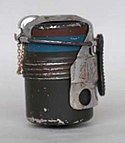
|
Grenade | |||
| VI.89 | 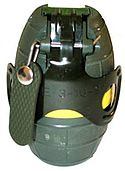
|
Grenade | |||
| M203 grenade launcher | 
|
Under-barrel grenade launcher | 40mm | ||
| GL09 Advanced Airburst Weapon | File:Advanced airburst weapon 2.png | Handheld automatic grenade launcher | 25mm grenades | ||
| SB LAG 40 | 
|
Automatic grenade launcher | 40mm |
Anti-tank weapons
| Name | Image | Origin | Type | Details |
|---|---|---|---|---|
| C90 | 
|
Shoulder-launched anti-tank weapon | ||
| C-100 | 
|
Shoulder-launched anti-tank weapon | ||
| MBT LAW | 
|
Shoulder-launched anti-tank weapon | ||
| BGM-71 TOW | 
|
Anti-tank guided missile | To be phased out | |
| Vesper missile | 
|
Anti-tank guided missile | Currently being produced to become standard issue | |
| Polyphem | Loitering missile | |||
| E-92 | 
|
Gun-launched ATGM | ||
| Scorpion missile | 
|
Heavy ATGM for helicopters and UAV's |
Combat vehicles
| Name | Image | Origin | Type | Numbers |
|---|---|---|---|---|
| C1 Aries | 
|
Main battle tank | 900 - those in active service have largely been upgraded to the AMV standard. | |
| VC80 | <imgur w=125>ZLqnhHf.jpg</imgur> | Main battle tank | 600 remaining, all mothballed in long-term storage | |
| VI.22 | 
|
Infantry fighting vehicle | 1027 | |
| VCC-3 Sagitus | 
|
Wheeled modular armoured platform | Equips four Motorised Legions . | |
| VCC-4 Neptunus | 
|
Wheeled modular armoured platform | Equips the Imperial Marines. | |
| VCC-1 & VCC-2 Testudo | 
|
Armoured Personnel Carrier | Latium's indigenous adaptation of the Belfrasian BMS Testudo. 1,500+ built, mostly in storage and to be phased out | |
| VI.01 | 
|
Wheeled APC | Mostly employed by support units | |
| VI.72 | 
|
Wheeled APC | Mostly in storage and to be phased out | |
| B1 Centaurus | 
|
Armoured reconnaissance vehicle/wheeled fire support vehicle | 500+ | |
| Bronco All Terrain Tracked Carrier | 
|
Articulated tracked vehicle | 100+, primarily used by mountain troops. | |
| Iveco LMV | 
|
General utility vehicle | ||
| MaxxPro | 
|
MRAP |
Artillery
| Name | Image | Origin | Type | Numbers |
|---|---|---|---|---|
| L16 81mm mortar | 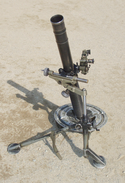
|
Medium mortar | ||
| M1064 mortar carrier | 
|
120mm self-propelled mortar | Equips Armoured and Armoured Infantry Legions | |
| M1064 mortar carrier | 
|
120mm self-propelled mortar | Equips Motorised Legions | |
| Mod 56 | 
|
105mm packed howitzer | 48, equips the Airborne Legion and the Mountain Infantry Legion | |
| FH70 | 
|
155mm towed howitzer | 24, equips the Imperial Marines | |
| Palmaria (artillery) | 
|
155mm Self-propelled howitzer | Upgraded with L/52 barrels for 40+km range with base-bleed and 50+km with rocket-assisted rounds, equips Armoured and Armoured Infantry Legions | |
| Sagitus 155 | 
|
155mm Self-propelled howitzer | Equips Motorised Legions | |
| TDI Ares | File:MLRS 05.jpg | Self-propelled rocket artillery | 100 |
Air Defence Weapons
| Name | Image | Origin | Type | Numbers |
|---|---|---|---|---|
| GDF | 
|
35mm twin AA gun | ||
| SIDAM 25 | 
|
Quad 25mm self-propelled AA gun | Being phased out | |
| Otomatic | 
|
76mm self-propelled AA gun | One battery of six vehicles per Armoured or Armoured Infantry Legion | |
| Sagitus 76 | 
|
76mm self-propelled AA gun | One battery of six vehicles per Motorised Legion | |
| FIM-92 Stinger | 
|
MANPAD | ||
| Aspide | Short-range SAM system | Being replaced by AD-16 | ||
| CAMM | 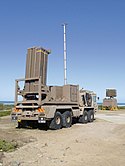
|
Medium-range SAM system | Equips divisional-level AA Cohort | |
| Archer Missile | 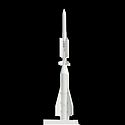
|
Long-range SAM system | Used to defend high-value static and semi-static assets |
Army Aviation
| Name | Image | Origin | Type | Numbers |
|---|---|---|---|---|
| AgustaWestland AW109 | 
|
Light utility/scout helicopter | ||
| A129 | 
|
Attack helicopter | ||
| Clios Peregrine | 
|
Medium-lift helicopter | ||
| Aigios Heron | 
|
Heavy-lift helicopter | ||
| AeroVironment RQ-11 Raven | 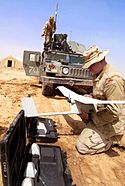
|
Miniature UAV | ||
| Falco | 
|
Medium UAV | ||
| MQ-1C Warrior | 
|
Long-endurance UCAV | ||
| Harpyia | 
|
Long-endurance loitering attack drone |
Battlefield surveillance
| Name | Image | Origin | Type | Numbers |
|---|---|---|---|---|
| Mobile Artillery Monitoring Battlefield Radar | 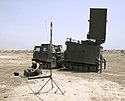
|
Counter-battery radar | ||
| RASIT | 
|
Battlefield surveillance radar | ||
| Giraffe radar | 
|
Battlefield air defence radar |
